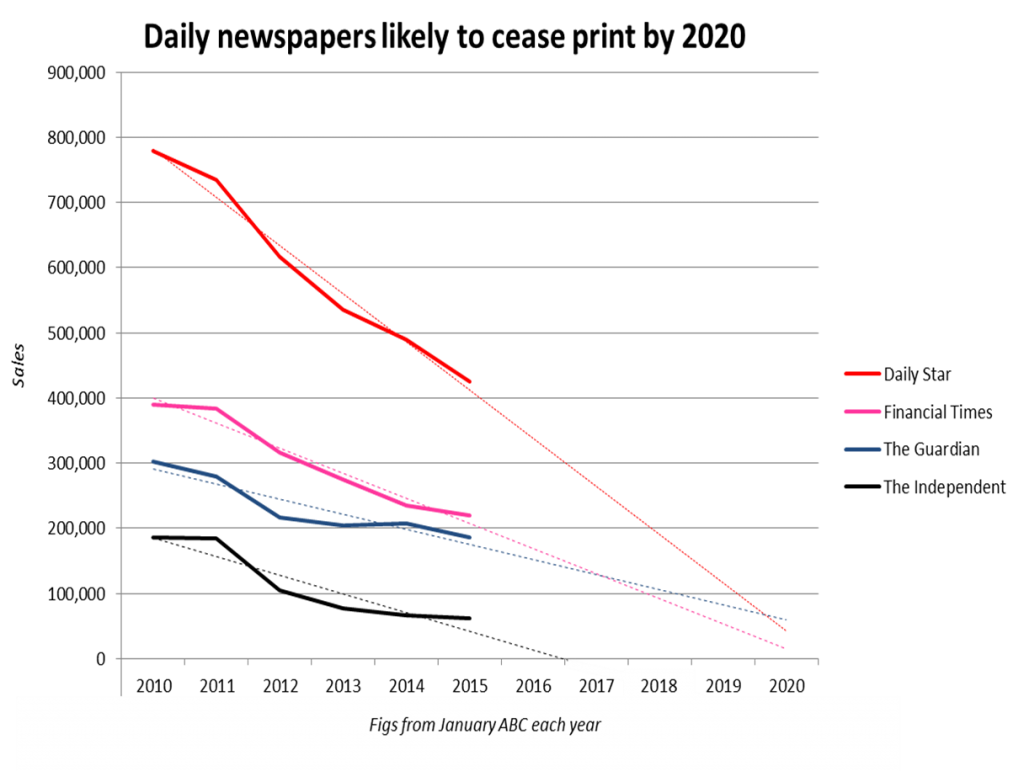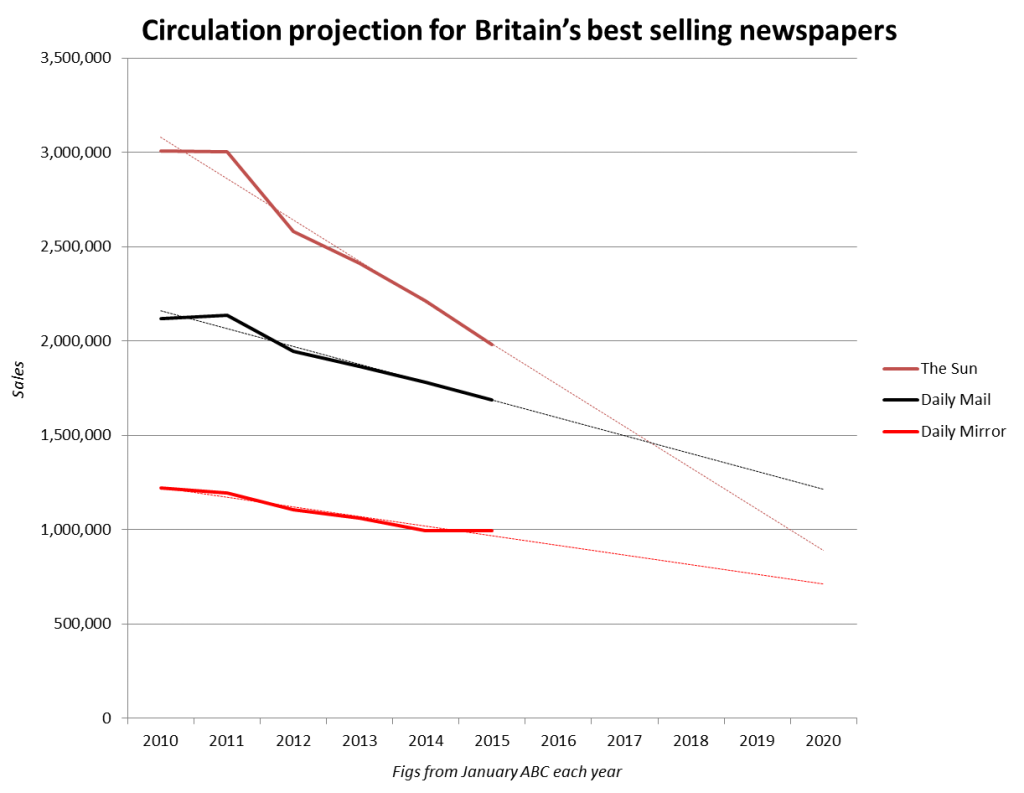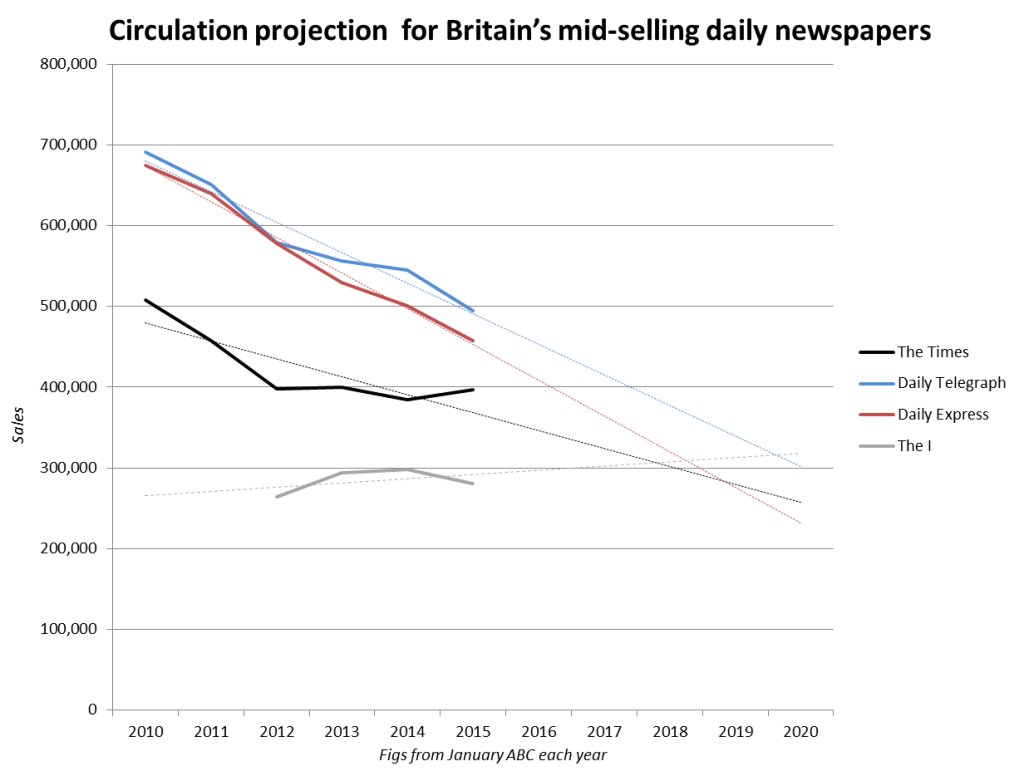by Atul Hatwal
This election will be the swansong of an institution which has dominated the media landscape for well over a century: the daily newspaper.
By 2020, if the trends established over the past five years continue, four out of 11 daily newspapers will likely have ceased print production.
Old certainties will crumble: the Sun will set – it will no longer have the biggest daily print circulation – and the Telegraph’s commanding lead as the most popular of the old broadsheets will almost entirely evaporate.
The papers likely to cease publication by 2020 are the Independent, the Guardian, the Financial Times and the Daily Star.
The Independent will probably be the first to end its print run. If the trend in print sales over the past five years continues, then it will literally run out of readers at the start of 2017.
This does not of course mean the Independent will cease to exist. It can continue online but unless the Lebedev family, or a new owner, is prepared to fund the print run of a paper that absolutely no-one buys, there will be no Independent newspaper in a couple of years.
Compared to the Independent, the Guardian seems relatively healthy. With 185,000 daily sales it still has a significant audience. However, by 2020 a combination of the high operating costs of print and declining sales will tip the balance towards the end of the physical newspaper.
The pie chart below from Clare Enders (as part of her evidence to Leveson) highlights the scale of cost incurred in a newspaper print operation.
The Guardian’s annual operating costs are £251m, which means that if Enders’ analysis is correct, £90.4m of the Guardian’s costs are due to printing and paper alone, versus £67.8m on editorial.
To put that in a commercial context, last year the Guardian registered a loss of £40.8m.
This doesn’t mean that ending print would automatically turn that loss into a profit – print advertising revenue and the subscription packages that bundle print and online access remain mainstays of its revenue model.
But if the decline in sales continues on trend, then a circulation of roughly 60,000 in 2020 means print related income will shrink and the costs will weigh ever heavier.
In the past the Guardian could sustain its losses because it cross-subsidised the newspaper with profits generated from its stake in Autotrader. But following the sale of this stake last year for a tidy £619m, this will not be possible any longer.
The nest egg from the sale sounds a lot, but large chunks of it have been allocated to expanding the global online operation and the remaining lump sum will run down very quickly if the Guardian keeps posting losses of £40m per year.
The costs of print, and the absence of an Autotrader cross-subsidy, mean that the end of print at the Guardian is almost as commercially certain as at the Independent. The single, biggest decision that Alan Rusbridger’s successor as editor is likely to have to make is when not if to scrap the daily newspaper.
The presence of the Financial Times on the graph might be a surprise to some. There has tended to be an assumption that the FT’s print sales are buoyed by bulk corporate purchasing, which are immune to the vagaries of the consumer market. However, the steep decline of the FT’s sales over the past five years would suggest otherwise.
On trend, by 2020, the FT’s print edition will have almost run out of readers entirely, registering barely a few thousand daily sales; an incredible fall from the position at the start of this parliament when the FT was selling almost 400,000 every day.
However, the benchmark for the biggest percentage fall is set by the Daily Star. Over the past five years the Daily Star’s print circulation has fallen off a cliff, from a high of just under 800,000 in 2010 to just over 400,000 at the start of this year – a drop of nearly 50%. At this rate of decline, the Daily Star will be selling less than 50,000 a day by 2020 and even with Richard Desmond’s notoriously tight control of costs, will be financially unsustainable.
In contrast, at the top end of the market, while the changes will be less dramatic, the projections are nonetheless significant: the Daily Mail will become Britain’s biggest selling newspaper as the Sun falls back.
The Sun has had a torrid time over this parliament. After sustaining its sales at three million during 2010-11, the impact of the Leveson Inquiry is evident with the loss of almost half a million readers in one year 2011-2012.
Since then, the rate of decline has slowed a little but the Sun will have lost over a million readers in this parliament, will be overtaken by the Daily Mail in late 2017 and, based on current trends, will dip below one million readers in 2020, for the first time since Rupert Murdoch bought the paper in 1969.
The Mirror has been a relative success story, with a far shallower rate of decline, even sustaining sales at 1 million over the past year. The contrast with the Sun’s performance is stark and if these trends continue, the Mirror is on track to overtake the Sun in the early years of the next decade.
Looking ahead to 2020 for the middle market, the big story is the fall of the Telegraph.
The Telegraph started this parliament with a significant lead in the old broadsheet market. Yet from a dominant position of almost 700,000 daily sales, it has fallen to less than 500,000 and unless the trend is arrested, will dip to 300,000 by the 2020 election.
In itself, this is not an existential threat for the Telegraph, but the Times’ comparatively stable sales mean that by 2020 the Telegraph’s position as biggest selling ‘quality’ newspaper will be under threat for the first time since the 1930s, when the Times briefly overtook it.
The one and only unalloyed print success over the past few years has been the i. The figures in the graph begin after its first full year of operation, once its sales had stabilised, and while these remain comparatively early days, it’s the only daily with an upward trend line. Sales dipped a little in the past year, but if it can return to trend growth, then the i would overtake the Times and Telegraph in the next five years.
In the background, the the Express continues a fall so long running that it has become one of the constants of the British newspaper market. The front page obsession with the weather, Diana and statins along with its shrinking readership has made the Express the butt of many media in-jokes.
The most striking feature of the Express’ sales over this parliament is how consistent the year on year decline has been – there’s practically no need for a trend line. From almost 700,000 daily readers to 457,000 today, the only way seems down.
Unless the Express brand is rescued and resuscitated soon, Richard Desmond will be responsible for single-handedly running his two newspapers – the Express and the Daily Star – into the ground and out of print.
The political impact of these changes in the daily print market will be particularly significant for Labour, for two reasons.
First, the party will lose two of its most powerful print backers: the Guardian and Independent.
This is important because print will continue to play a powerful role in setting the wider news agenda. The nightly TV reviews of the front pages and flurry of tweets as they are revealed, are firmly established fixtures within the news cycle.
And a paper splashing on a story means much more to a broadcast news editor, deciding on his or her running order, than something featured prominently on the home page.
What’s more, a print newspaper, unlike online, is a uniquely British product.
For politicians trying to push a domestic message, and journalists trying to write UK political stories, the newspaper remains a critical outlet compared to online where the melange of matey faux-social headlines, soobs, hyperbolic rage-bait, memes and internet fads, all optimised for global clicks, swamps any broader narrative.
Without a print Independent and Guardian, Labour will face a tougher challenge communicating its message.
Second, the replacement of the Sun by the Mail as Britain’s top selling daily will be problematic. There’s an extra cachet and influence for the biggest seller with other media outlets – its editorials and political views are news in themselves. Despite Labour’s current antipathy to all things Murdoch, the Sun did support Labour for the majority of its time in government. Could anyone imagine similar from the Mail?
But simply bemoaning the deepening anti-Labour bias of the press, or the absence of print opportunities will be no use for Labour in the next parliament – these will be the circumstances in which it operates and all parties, and news organisations, will need to adapt. A brave new media world beckons.
Atul Hatwal is editor of Uncut
Tags: Atul Hatwal, FT, Guardian, Independent, newspaper circulation, online media, print press, Sun, Telegraph













The Guardian a Labour supporting paper?! I must have been reading the wrong Guardian, as its anti Labour bias has become something noted by many. It led,a practical crusade against Milliband last Autumn. The Independent can best described as neutral. Both these newspapers,actively supported libdems in 2010.
Must have been a different Guardian you’re reading then. The one I stopped buying after forty years is more and more loony left/Labour and will very soon disappear.
It gives space to people like Matthew Taylor whose article on the front page today about ethnic minority unemployment is complete and utter rubbish and is rightly being taken apart.
The Guardian isn’t a newspaper but an opinion giver, it tells metropolitan Labour who are busily destroying Labour how to think. It supports any anti-establishment crackpot and wallows in victimhood. It selectively reports on topics it wants to push onto the political agenda rather than the news. It is now obsessing about the three Jihadi brides but rarely about the 1400 in Rotherham, it also keeps trying to form the opinion that the last GTMO resident (a Saudi caught in Afghanistan who was given UK residency) is somehow our responsibility. An example is that there was nothing about the Jaguar factory worker who was telling Miliband how it is for blue collar workers. Most comments on politics are an irrational hate-fest, look at any comments on the Conservative policy (IDS, Gove and May), Blair and any Labour moderates, deficit reduction etc. Look at any comments by Polly Toynbee . Rather than rational discussion it is the ying for the DM yang. It doesn’t deserve to survive.
..and The Scotsman will probably die the death as well.
Fifty years ago as a student I read the Times, and the Guardian which were free if you worked in the student library. And the Telegraph … and the Daily Worker..
Twenty years ago I read the Guardian and the Telegraph. And the FT.
All paper newspapers.
Nowadays I buy the Telegraph on Saturday. Period. And read the Telegraph, Guardian, Independent, Mail etc on the internet. Free.. (the Telegraph firewall is leaky).
Why do I read lots of newspapers? Answer: because they all lie.. and distort..so you sometimes may get reality..
Will I pay money to read an internet one? Nope.
They are doomed.
Madas – to get unlimited access to the Telegraph, use the Google Chrome browser and install the ‘incognito’ extension. It fools their IP monitoring into thinking each time you visit is the first time you’ve ever visited.
works on the FT as well but not as spectaculalry
Tafia
Thanks. for the tip…